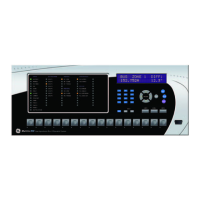CHAPTER 5: SETTINGS GROUPED ELEMENTS
B90 LOW IMPEDANCE BUS DIFFERENTIAL SYSTEM – INSTRUCTION MANUAL 5-157
5
BUS ZONE 1 DIF LOW SLOPE — This setting defines the percentage bias for the restraining currents, from zero to the lower
breakpoint (
LOW BPNT). This setting determines the sensitivity of the relay for low current internal faults. The value chosen
needs to be high enough to accommodate the spurious differential current resulting from inaccuracy of the CTs operating
in their linear mode, i.e. in load conditions and during distant external faults. When adjusting this setting, it must be kept in
mind that the restraining signal used by the biased bus differential protection element is created as the maximum of all the
input currents.
BUS ZONE 1 DIF LOW BPNT — This setting defines the lower breakpoint of the dual-slope operating characteristic. The
percentage bias applied for the restraining current from zero to the value specified as LOW BPNT is given by the LOW SLOPE
setting. This setting needs to be set above the maximum load current. The
LOW BPNT can be moved to the AC current
under which all the CTs are guaranteed to transform without saturation. This includes the effect of residual magnetism.
When adjusting this setting, keep in mind that the restraining signal is created as the maximum of all the input currents.
BUS ZONE 1 DIF HIGH SLOPE — This setting defines the percentage bias for the restraining currents above the higher
breakpoint (HIGH BPNT). This setting affects stability of the relay for heavy external faults. Traditionally, the value chosen for
this setting needs to be high enough to accommodate the spurious differential current resulting from saturation of the CTs
during heavy external faults. This requirement can be considerably relaxed in favor of sensitivity and speed of operation as
the relay detects CT saturation and upon detection applies the directional principle to prevent maloperation. When
adjusting this setting, keep in mind that the restraining signal is created as the maximum of all the input currents.
BUS ZONE 1 DIF HIGH BPNT — This setting defines the higher breakpoint of the dual-slope operating characteristic. The
percentage bias applied for the restraining current above the value specified as
HIGH BPNT is given by the HIGH SLOPE
setting. The
HIGH BPNT setting needs to be set below the minimum AC current that is likely to saturate the weakest CT
feeding the relay. When adjusting this setting, it must be kept in that mind the restraining signal is created as the
maximum of all the input currents.
The dual-slope operating characteristic of the biased bus differential protection element is shaped to ensure true
percentage bias for high restraining currents (see the following figure). This means that the straight line defining the upper
slope intersects the origin of the differential-restraining plane and a discontinuity appears between the low and high slope
regions (between the
LOW BPNT and HIGH BPNT settings). This discontinuity is handled by approximating the operate/no-
operate boundary of the characteristic using a certain “gluing” function. This ensures smooth transition of the slope from
LOW SLOPE (lower value) to HIGH SLOPE (higher value).
The following parameters of the biased operating characteristic are used by the saturation detector:
LOW SLOPE, HIGH
SLOPE
, and HIGH BPNT. The saturation detector uses these settings to detect specific relations between the differential and
restraining currents. The values of these settings are selected based on the aforementioned criteria related to the art of
bus differential protection.
BUS ZONE 1 DIF HIGH SET — This setting defines the minimum differential current required for operation of the unbiased bus
differential protection function. This setting is based on the maximum magnitude of the differential current that might be
seen during heavy external faults causing deep CT saturation. When selecting this setting, keep in mind that the unbiased
bus differential protection function uses the full-cycle Fourier measuring algorithm and applies it to pre-filtered samples of
the input currents. As a result, the transient measuring errors including the effect of the DC component are below 2%.
During heavy CT saturation when the currents are significantly distorted, the magnitude of the differential current as
measured by the relay and used by the unbiased bus differential function is significantly lower than both the peak values
of the waveform and the true RMS value. The measured magnitude practically reflects the power system frequency
component alone. This allows for lower values of the
HIGH SET setting.
The unbiased (high set) differential function can be virtually disabled by setting its operating threshold,
HIGH SET, very high.
BUS ZONE 1 DIF SEAL-IN — This setting defines the drop-out time of the seal-in timer applied to the BUS 1 OP FlexLogic
operand.
BUS ZONE 1 DIFF SUPV — This setting specifies a FlexLogic operand that supervises operation of the element. Typical
applications include undervoltage condition and overall (check) zone. In a sense the setting is similar to the blocking input,
but does not stop the element from running. This is important for saturation detector, as the latter requires some historical
data. The Bus Differential element shall not be supervised from the blocking input. The blocking input (
BUS ZONE 1 DIF BLK
setting) is meant to block the element permanently, not dynamically from a fault depended condition such as
undervoltage.
BUS ZONE 1 DIF TRIP — This setting specifies a FlexLogic operand that forces operation of the zone. Typical applications
include forced trip of the healthy phase from the faulted phase, or a trip command from the BF function to isolate the
entire zone of busbar protection.

